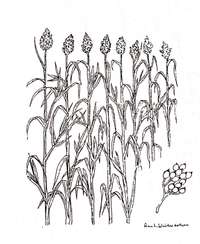- A Technical Note on Dry Farming
- Partially Buried Flower Pots or Tin Cans Save in Watering
- Capturing Water from Fog
- Drip Irrigation
- Book Reviews: Ways of Water: Run-off, Irrigation and Drainage and Vanishing Land and Water: Soil and Water Conservation in Dry Lands
- Book Review: Looking After Our Land: Soil and Water Conservation in Dryland Africa
- Book Review: Practical Guide to Dryland Farming Series
- Book Review: Handbook for Agrohydrology
- "Waterlines" from IT Publications
- The Arid Lands Information Network
- Training in Infrastructure for Developing Countries
A TECHNICAL NOTE ON DRY FARMING by Randy Creswell in Mali, West Africa, is available from ECHO. This 18-page note gives specific technical guidelines for growing plants in arid regions. Randy defines dry farming as "the profitable production of crops, without irrigation, on land with a low average or highly variable rainfall." The document gives practical steps for increasing water absorption, reducing the loss of soil moisture, suitable cropping systems, mulching, plowing and tillage, planting, and a series of tables on requirements of drought-resistant crops.
You may know of special techniques or plants for arid regions that may also help other readers. The quality of EDN is greatly increased as our readers share their best ideas with us. Please write!
PARTIALLY BURIED FLOWER POTS OR TIN CANS SAVE IN WATERING. Like many of you, we have a very long dry season at ECHO. Many plants are beyond the reach of our irrigation system. Even though we have the luxury of reaching them with a garden hose, it can still be quite a task (and waste of water) to get the soil sufficiently wet in the root zone of a fairly recent planting. Often I have had the water flowing for five minutes only to find that the soil is dry an inch below the surface. Forming a shallow basin around the tree can help, but it must be reconstructed and much of the water remains near the surface and quickly evaporates.
Now when we transplant a tree we bury an old flower pot with drainage holes just outside the rootball. The size is not too  important; we use about a 15 cm (6 inch) diameter pot. When watering we quickly fill the pot once or twice and we are done. All the water is channeled directly into the soil near the rootball. Sometimes we throw a pinch of fertilizer into the pot.
important; we use about a 15 cm (6 inch) diameter pot. When watering we quickly fill the pot once or twice and we are done. All the water is channeled directly into the soil near the rootball. Sometimes we throw a pinch of fertilizer into the pot.
This is a takeoff on a technique you may have read about. In some arid regions farmers grow plants next to a buried porous clay pot. That would no doubt provide a slower more controlled release of water, but it has two disadvantages. First, it sounds expensive (if such pots are even available). Secondly, the very slow release of water would encourage roots to concentrate only around the pot. The water rather quickly leaks out of the regular flower pot (no doubt some is lost to the plant when it is young) but forms a "ball" of moist soil into which a large quantity of roots can grow.
In parts of my own garden I have started using this technique for vegetables and flowers also. I place the bottom of the pot about 3 inches deep and cluster plants around it, the number and spacing depending on the size of the mature plant. A benefit I had not anticipated is that small weed seeds near the surface of the soil are less likely to germinate because the surface remains dry.
I was pleased to read in the July-September 1991 issue of Agroforestry Today that a farmer in Kenya has devised and used a very similar approach. George Nti'Gitonga "realized that the normal period for planting--during the rainy season--was not the best time to establish seedlings. There were two reasons: a labor bottleneck due to work [with other crops]... and difficulties in working the heavy clay soils when they were wet." Also he knew the rains might not come.
"So Mr. Nti'Gitonga plants his trees during the dry season, when the soil is powdery and he and his family have more time.... He buries an old tin can next to each tree seedling with a small hole punched near the bottom on the side facing the tree. The farmer fills the can with water, which runs out quickly into the dry soil. He then fills the can again and covers it with a stone (to prevent evaporation).... Using this method he needs to water his seedlings only once a week. In fact, they can survive 2-3 weeks without additional watering." Using this method, he has established 25,000 trees on his farm. Recently he won first prize in a national contest to reward farmers for outstanding contributions to rural tree planting.
Dr. Carl Campbell at the University of Florida responded to this article: "I was especially interested to read about the use of pots or cans sunken into the ground for watering plants. I have been doing that in a limited way for a long time too, and have seen and read about many cases in which the method is used. For me a useful variation is to leave the container above ground, on the surface, so it can be moved to water more than one plant. I like to use large plastic jugs with a very tiny hole when I am going to be gone for a few days and have some tender, newly planted trees."
CAPTURING WATER FROM FOG for household or agricultural use is a promising technology. It is not a new idea: African nomads and Andean people have long taken advantage of trees' natural water-catching properties by collecting morning dew or using the water trapped by forests. But now scientists around the world are working to enable more dryland communities to harvest the fog water in their regions.
The technology is simple: polypropylene meshes are set up vertically in areas with dense fog and light winds. As the fog passes through the mesh, the suspended water droplets are caught by the net and drip down into a collection trough and are channeled into a storage tank. Water captured by the nets is of excellent quality--fog is a long-term sustainable resource much more reliable in both availability and safety than groundwater in many areas. This technology is best suited to upland areas with persistent fogs that limit visibility to 100 m or less and light winds (about 10 km/h) needed to carry the fog through the mesh. The knitted polypropylene meshes known to be effective are inexpensive (about US$0.25 per m2), durable, and available from many sources worldwide.
In 1995, three ECHO staff visited one site just north of Quito, Ecuador, in which the water-catching nets have been successfully installed. The area near the Mitad del Mundo ("Middle of the World") equatorial monument is a dry, eroded zone plagued by dust storms. Nearby is a fertile volcanic crater called Pululahua, an ecological reserve known for its unique vegetation. The people above the crater can see the near-constant fog from distant humid valleys which blows across the crater and over their dry land. A few years ago, trial fog collectors of 1 sq m were erected on the ridge above the crater (at 2830 m elevation) to catch water droplets in the fog that passes through the nets. The trial collectors harvested up to 20 liters of water a day, with a daily annual average of 12 liters. Based on these results, sixty-three 4.5 m x 6 m mesh panels were set up on the ridge and are now capturing water for the nearby arid community.
Fog collection is one of the most hopeful water-harvesting technologies for certain zones. It is not suited to every area, however, and trial nets are a wise investment if you believe fog collection has promise in your area. Some limitations include very strong winds which can damage the collectors, not enough wind, insufficiently dense fog, and inaccessible sites. A collector (two vertical posts mounted in well-packed holes and anchored with strong cables, mesh secured with cables, and a plastic collection trough) with a 50 m2 surface area could cost US$300-500, which could cost significantly less than buying water from trucks, for example.
Dr. Robert Schemenauer of Environment Canada is a cloud physicist and one of the primary researcher-promoters of fog collection. He sent ECHO some excellent publications on site evaluation for fog harvesting, details on setting up a trial net, sources of mesh, and more. Write to ECHO for this introductory information if you see a potential for your area. Address more specific correspondence to Dr. Schemenauer at Atmospheric Environment Service, 4905 Dufferin St., Downsview, Ontario M3H 5T4 CANADA; fax: 416/739-4211. There will be a July 1998 conference on fog collection in Vancouver, BC, Canada; write Dr. Schemenauer for more details.
DRIP IRRIGATION was demonstrated at ECHO's 1995 conference by Dick Chapin and former ECHO intern Beth Adams, who taught vegetable production in Malawi. Chapin Watermatics produces "bucket kits" of gravity-run drip irrigation used in vegetable garden projects in developing countries. These kits enable people to produce vegetables with the same efficient use of water that commercial drip systems provide. The system consists of a 5-gallon bucket mounted 1 m above soil level, a 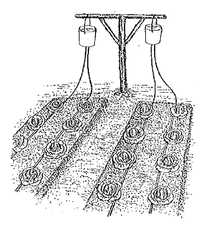 filter-stopper fitted into a hole in the bottom of the bucket, two connecting tubes, and two 50-foot (15m) lines of 15-mil drip tape with outlets 12" (30cm) apart. (Buckets are not provided with the kits.) Prepare the garden beds 15 m x 1 m for two rows of plants. Lay one drip line along each side on the surface of the bed. Fill the buckets and transplant alongside the drip tapes near the holes. The buckets need to be filled twice daily with water; soluble fertilizer or manure tea can be used as needed. Mulch placed over the tape reduces surface evaporation. The kits can produce vegetables for up to 5 years if carefully maintained.
filter-stopper fitted into a hole in the bottom of the bucket, two connecting tubes, and two 50-foot (15m) lines of 15-mil drip tape with outlets 12" (30cm) apart. (Buckets are not provided with the kits.) Prepare the garden beds 15 m x 1 m for two rows of plants. Lay one drip line along each side on the surface of the bed. Fill the buckets and transplant alongside the drip tapes near the holes. The buckets need to be filled twice daily with water; soluble fertilizer or manure tea can be used as needed. Mulch placed over the tape reduces surface evaporation. The kits can produce vegetables for up to 5 years if carefully maintained.
ECHO is evaluating this drip system in some of our garden beds. The plants are growing very well. We anticipate that foliar diseases, sometimes spread by overhead irrigation, should be reduced. The kits are suitable for vegetable production in our dry season.
Dick Chapin offers a free demonstration kit, literature, and video for agricultural missionaries in developing countries. Further kits can be purchased for a small fee. Contact Dick Chapin at 368 N. Colorado Ave., Watertown, NY 13601, USA; phone 315/786-8120 or 788-0891; fax 315/782-1490.
WAYS OF WATER: RUN-OFF, IRRIGATION AND DRAINAGE (382 pp.) by Hugues Dupriez and Philippe De Leener is an excellent handbook on water management, full of clear diagrams and photos (both close-ups and aerial). Topics are grouped into bite-sized lessons several pages long. Section headings include water and soil, water in plants, water in the air, surface water, watering crops, irrigation methods and efficiency, and lifting water. This is a comprehensive resource, readable with 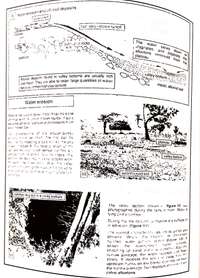 well-illustrated details on every topic. VANISHING LAND AND WATER: SOIL AND WATER CONSERVATION IN DRY LANDS (117 pp.) by J.L. Chleq and H. Dupriez is another book in the same series. This one covers erosion causes and control, wells, and water lifting. It is also illustrated in the same style; see 'page' at right. Available in French and English. African, Caribbean, and Pacific nationals may contact CTA, Postbus 380, 6700 AJ Wageningen, NETHERLANDS; also available (œ13.99 and œ5.95, respectively) from IT Publications; see below under "Waterlines."
well-illustrated details on every topic. VANISHING LAND AND WATER: SOIL AND WATER CONSERVATION IN DRY LANDS (117 pp.) by J.L. Chleq and H. Dupriez is another book in the same series. This one covers erosion causes and control, wells, and water lifting. It is also illustrated in the same style; see 'page' at right. Available in French and English. African, Caribbean, and Pacific nationals may contact CTA, Postbus 380, 6700 AJ Wageningen, NETHERLANDS; also available (œ13.99 and œ5.95, respectively) from IT Publications; see below under "Waterlines."
LOOKING AFTER OUR LAND: SOIL AND WATER CONSERVATION IN DRYLAND AFRICA. Oxfam and the arid lands unit of the International Institute for Environment and Development have teamed up to make a video and book duo that is a welcome addition to our video library. The book contains many excellent pictures and illustrations, and the tape is informative with a lot of content at a modest price.
Oxfam writes, "The book and video have been produced expressly for development workers in arid and semi-arid Africa, but will also be of general interest to a wider audience... It is suitable for use in workshops and discussion groups and the material is reinforced by the book. [Ed: I would go further than that. The book gives a lot of technical details that either are not in the video or were not obvious, but which you are going to need when time comes to try the methods.]
"The video and book are about the main lessons to be learned from new approaches to soil and water conservation in sub-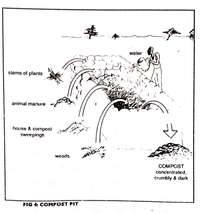 Saharan Africa. Six case studies, two each from Burkina Faso, Kenya and Mali, show how, in the wake of many failures, some success has been achieved in projects where the participation of local people has been recognized as the crucial issue." The authors/producers deal with both the social and technical side of the work.
Saharan Africa. Six case studies, two each from Burkina Faso, Kenya and Mali, show how, in the wake of many failures, some success has been achieved in projects where the participation of local people has been recognized as the crucial issue." The authors/producers deal with both the social and technical side of the work.
The 2-hour tape costs L14.95 and the very well illustrated 88-page book œ8.95. Order from Oxfam Publications, c/o BEBC, PO Box 1496, Parkstone, Poole, Dorset BH12 3YD, UK; phone 01202 715555; fax 01202 715556. BE SURE TO SPECIFY whether you want the English or French version AND whether your video equipment uses the PAL, SECAM or NTSC system. Add for postage: 20% in the UK, 35% Far East and 25% elsewhere. (The book only is available for US$14.95 from Humanities Press, 165 First Ave., Atlantic Highlands, NJ 07716, USA; phone 908/872-1441.)
PRACTICAL GUIDE TO DRYLAND FARMING SERIES. Lucy Fisher with World Neighbors in Indonesia sent us a copy of this wonderful set. I am excited about it for several reasons. It is unbelievably well illustrated with detailed drawings. It deals with subjects that are of great interest to many development workers. It describes in detail several of the techniques that have been the basis for some dramatically effective projects by many groups in various countries. Finally, at $4 per booklet, it is a good price.
Titles of the four units are: Introduction to soil and water conservation practices, Contour farming with living barriers, Integrated farm management, and Planting tree crops.
Lucy wrote, "We have been reading EDN for several years, and have found much that has been relevant to the agricultural programs we assist in Southeast Asia. Perhaps some of your readers would be interested in the agricultural extension booklets used in the programs we support here in Indonesia and the Philippines." Originally published in Indonesian, they are now available in English.
"While the methodologies discussed are specifically applicable to the conditions found in the semi-arid regions of SE Indonesia, many are relevant throughout the uplands in the tropics.
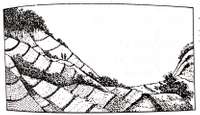 "The first book, 44 pages, discusses the basic principles of soil and water conservation on sloping land. Design, construction, use and maintenance of contour-based systems (hedgerows, rock barriers and bench terraces) to reduce erosion and increase rain water absorption are described.
"The first book, 44 pages, discusses the basic principles of soil and water conservation on sloping land. Design, construction, use and maintenance of contour-based systems (hedgerows, rock barriers and bench terraces) to reduce erosion and increase rain water absorption are described.
"The second book, 40 pages, considers the reasons for contour farming with terraces as well as methodology. Details include finding the contour lines of the slope, dike/ditch preparation, hedgerow species selection and planting, maintenance of terraces, and alternative uses for the living barriers (which include a variety of leguminous shrubs and grasses).
"The third book, 36 pages, covers integration and diversification of upland farming activities to reduce risk and increase farm productivity. Soil and water conservation is promoted as the basis for integrated farming. Topics include soil fertility, cropping practices and patterns, livestock, tree crops, cover crops, wood production and environmental conservation.
"The fourth book, 38 pages, covers integration of tree crops into the farming system, uses of tree crops, propagation methods (seed, stakes, grafting, air-layering), nursery construction and maintenance, planting out/transplanting, and subsequent care of trees. It also includes a planning worksheet and tables of suggested tree species according to use."
Booklets are $4 each plus postage, English only. Order from World Neighbors, 4127 NW 122 St., Oklahoma City, OK 73120-8869, USA; phone 800/242-6387 or 405/752-9700; fax 405/752-9393. For the Bahasa Indonesian version, write to Studio Driya Media, Jl. Makmur, 16 Bandung, West Java, INDONESIA.
HANDBOOK FOR AGROHYDROLOGY (281 pp.) provides details on the practical aspects of hydrological research in agriculture. If you are evaluating the need for runoff water or rainwater collection and soil erosion control, learning about soil moisture, designing a water harvesting plan, or processing water statistics, this book will be extremely useful to you. The book is written for agricultural staff without hydrological expertise who work in developing countries, where proper use of limited resources is critical but extensive data is usually not available. Some mathematical/chemical background is necessary in using this book, although the text is clear enough to be very informative for even the beginner in this field.
Agrohydrology uses an understanding of water processes to increase crop production, largely by optimizing soil moisture. The three main sections of the book are: Runoff and its measurement, Water harvesting and field structures, and Data analysis. 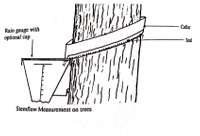 The equipment used in data collection is also covered in depth.
The equipment used in data collection is also covered in depth.
The chapter "Water Harvesting and Field Structures" covers three scales of systems. Micro systems concentrate water over an area of less than 1 meter, such as tied ridges and furrows (construction details and examples from Botswana and Zimbabwe). Meso techniques gather runoff from within a few meters, such as zai holes, contour bunds or ridges, diamond-shaped basins, and strip tillage. Macro systems, including broad flat catchments over large areas, are described with details on their feasibility and design.
The book is available for L30 including surface mail from Publications Distribution Office, Natural Resources Institute, Central Avenue, Chatham Maritime, Kent ME4 4TB, UK. No charge is made for single copies sent to governmental, educational, research, and non-profit organizations in countries eligible for British Government Aid. Use your official title and write on letterhead when requesting a free copy.
"WATERLINES" FROM IT PUBLICATIONS is "the world's only magazine devoted entirely to low-cost water supply and sanitation. It is written for professionals--administrators or engineers, project managers or policymakers, trainers or workers in the field." It is quarterly, and the cost for individuals is L15/$28 per year (L21/$40 airmail). ECHO has not seen this magazine, but coming from IT, we expect that it would be very useful. Write to subscribe and request a catalog: IT Publications, 103-105 Southampton Row, London WC1B 4HH, UK; phone +44 171 436 9761; fax +44 171 436 2013. The IT catalog lists over 60 of the best books on water conservation, supply, sanitation, scarcity, irrigation, pumps, filtration, and harvesting.
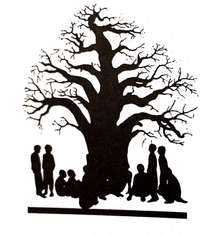 THE ARID LANDS INFORMATION NETWORK (ALIN) in Senegal is an organization primarily for field workers to share their practical knowledge of development work in arid and semi-arid areas of Africa. They offer networking opportunities with other people doing similar work in your area, helpful booklets on development topics, and the fine publication Baobob. Baobob is written three times a year (English and French) by ALIN members who exchange ideas and experiences in community development in Africa. Members receive all ALIN publications free of charge. Membership is free to all individuals working in dryland areas of Africa; paid subscriptions are available for other organizations and individuals. Write ALIN at Casier Postal 3, Dakar-Fann, SENEGAL; phone 221 25 18 08; fax 221 25 45 21. Direct all subscription enquiries for Baobob to Sally Lane, ALIN, 274 Banbury Road, Oxford OX2 7DZ, UK; tel 44 865 312402; fax 44 865 312600.
THE ARID LANDS INFORMATION NETWORK (ALIN) in Senegal is an organization primarily for field workers to share their practical knowledge of development work in arid and semi-arid areas of Africa. They offer networking opportunities with other people doing similar work in your area, helpful booklets on development topics, and the fine publication Baobob. Baobob is written three times a year (English and French) by ALIN members who exchange ideas and experiences in community development in Africa. Members receive all ALIN publications free of charge. Membership is free to all individuals working in dryland areas of Africa; paid subscriptions are available for other organizations and individuals. Write ALIN at Casier Postal 3, Dakar-Fann, SENEGAL; phone 221 25 18 08; fax 221 25 45 21. Direct all subscription enquiries for Baobob to Sally Lane, ALIN, 274 Banbury Road, Oxford OX2 7DZ, UK; tel 44 865 312402; fax 44 865 312600.
TRAINING IN INFRASTRUCTURE FOR DEVELOPING COUNTRIES. Water, Engineering and Development Centre (WEDC) sent us information about their unique courses. WEDC is a unit within Loughborough University of Technology devoted to training, research and consulting related to the planning, provision, operation and maintenance of water supplies, sanitation and physical infrastructure in developing countries. They offer an interesting variety of short courses (3-12 weeks) and Masters-level courses.
Examples of 12-week diploma programs include "Irrigation and Water Resources," "Community Technology for Rural Development," "Groundwater Development," Infrastructure for Low-income Urban Housing," "Management of Municipal Services," Project Preparation for Environmental Engineering," "Solid Waste and Environmental Management," "Urban Water Supply," "Wastewater and Irrigation," et. al. Shorter courses are offered on related topics. Special individual study programs, in-country training, and Masters or Doctorate research is also possible.
Twelve-month MSc courses which focus on developing countries include "Water and Waste Engineering," "Water and Environmental Management," "Urban Engineering," "Urban Water Supply," "Technology and Management for Rural Development," and "Planning and Management of Urban Services." These programs cost L9,250 in 1996-97 for continuous study.
Request fliers giving details and costs for any of the above from the Admissions Secretary, WEDC, Loughborough University of Technology, Leicestershire, LE11 3TU, ENGLAND; phone 0(44)1509 222885; fax 0(44)1509 211079; e-mail wedc@lut.ac.uk.
